This report is written by Xangle and authorized by LianGuaiNews for translation and joint release.
Key Highlights
- Aptos is a PoS blockchain developed by the former Meta Diem team, focusing on speed and reliability. Aptos is designed to achieve a theoretical throughput of over 100,000 and sub-second latency. It supports the Move programming language and provides a stable, fast, and flexible development environment.
- Technology itself does not guarantee success. Aptos adopts two key strategies to ensure sustainability and survival in the L1 war: 1) implementing a future-oriented network through scalability, and 2) expanding its ecosystem through Web2 partnerships. This approach involves introducing verified products and services and leveraging the intellectual property and user base of Web2 companies. This is also a bet on the future of the blockchain industry, predicting that the future of the blockchain industry will be driven by global heavyweight companies rather than Web3 startups.
- Aptos is likely to build its own ecosystem around the gaming field. It is one of the few public blockchains that can technically support 3A games. Aptos also actively collaborates with METAPIXEL to build the infrastructure and tools needed for Web3 game development, leveraging their rich expertise in game development. We expect that the features currently under development, including token object model, delegated gas payment, VRF, and game SDK, will streamline the development process for game companies. In addition, the highly anticipated “Gran Saga: Unlimited” (GSU), which adopts NPIXEL’s famous IP, is planned to be launched in January next year.
1. Introduction
The ultimate goal of all L1 blockchains is to become a global database infrastructure that can accommodate tens of millions of users accessing it simultaneously by solving the blockchain impossible triangle problem. In the 13 years since the birth of Bitcoin in 2009, no blockchain has been able to solve this problem. Existing blockchains encounter limitations and often require trade-offs, such as compromising decentralization or slowing down speed, which leads to a range of issues like network congestion, shutdowns, and high gas fees.
For this reason, the blockchain industry has proposed modular architecture in recent years, where different chains handle consensus, data availability, settlement, and execution separately. The main advantage of modular architecture is that each chain can specialize in a specific role, reducing the load on nodes and improving the overall performance of the blockchain. Many blockchains, including Ethereum, Avalanche, and Cosmos, are currently adjusting their roadmaps around modular architecture.
- Why is Ripple still facing centralization warnings?
- World’s First Case Is Profiting from Hacking Exchange Smart Contracts Considered Fraud?
- Blockchain Capital Why do we lead the $40 million financing round for ZK infrastructure company RISC Zero?
However, modularization also has its limitations. It weakens interoperability and composability between dApps, fragments liquidity, and hinders user experience. Most importantly, modular blockchains face a wider range of attack vectors, leading to security issues. Aptos is a new PoS-based blockchain designed within an integrated architecture to address such security challenges. It aims to provide stable and fast blockchain infrastructure for users around the world.
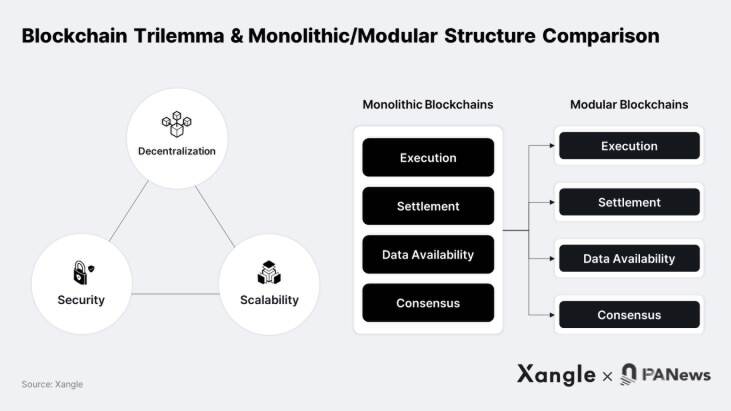
2. Aptos Internal: Technology and Features
2-1. Technology: Achieving High Scalability Through Efficient Consensus and Parallel Processing
Scalability is a major challenge for permissionless public blockchains. Scalability is primarily related to the processing speed of the blockchain, usually measured by throughput and latency. Currently, the actual demand for Aptos block space is relatively low, averaging 6-7 TPS. However, this technology is theoretically capable of achieving 100,000+ TPS and sub-second latency. Considering that VISA and Mastercard process approximately 3,000 to 4,000 transactions per second, this is undoubtedly an impressive number. Aptos’ ability to achieve such high scalability is largely attributed to the adoption of technologies such as Quorom Store (Narwhal), State Delta Synchronization, and Jellyfish Merkle Tree (JMT). Its core lies in its own consensus mechanism (AptosBFT v4) and parallel processing engine (BlockSTM).
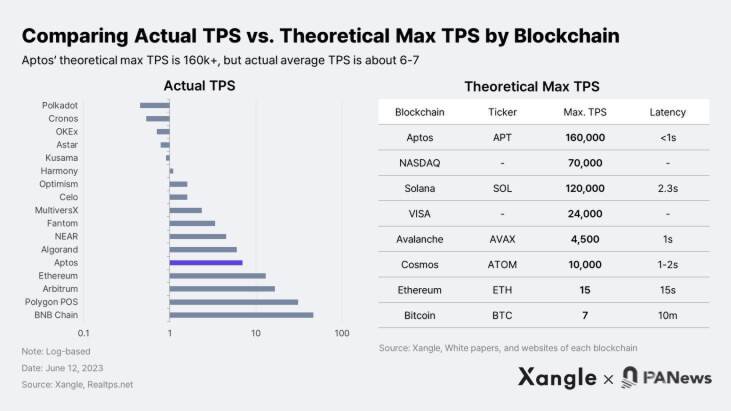
AptosBFT v4 is a consensus algorithm based on DiemBFT, developed by Diem (formerly Libra), a blockchain project of Meta. It has the characteristics of low network load and fast consensus speed, with significant improvements over the previously popular PBFT consensus mechanism. This is due to: 1) linear communication and linking techniques that improve latency and network efficiency, 2) fast synchronization between validators through efficient timeouts, and 3) a reputation system that quickly analyzes on-chain states to filter out unqualified validators in the leader node selection process.
BlockSTM is a parallel execution engine for smart contracts that utilizes software transactional memory, a technology that extends the ACID properties of database transactions to parallel programming. Unlike existing mechanisms that require processing transactions in block order, BlockSTM distributes independent transactions to multiple threads for parallel execution. By predefining the order, pre-execution, post-validation, and consensus can be achieved. This means that the introduction of BlockSTM can solve the bottleneck problem of blockchain and achieve breakthroughs in transaction processing speed.
2-2. Language: Building a Stable and Flexible Development Environment with Move
As Ethereum becomes a major component of the cryptocurrency field, “EVM compatibility” has become a strong narrative. In fact, only a few non-EVM L1s do not use Solidity, namely Solana on Rust, Cosmos on Cosmwasm, Stacks on Clarity, and Sui and Aptos on Move. However, it is no secret that the EVM environment and Solidity are susceptible to attacks. Over the past few years, many hacker attacks have exposed such vulnerabilities. According to Chainalysis data, from 2016 to 2022, in the past seven years, hacker attacks have caused nearly $9.9 billion in losses to the cryptocurrency industry.
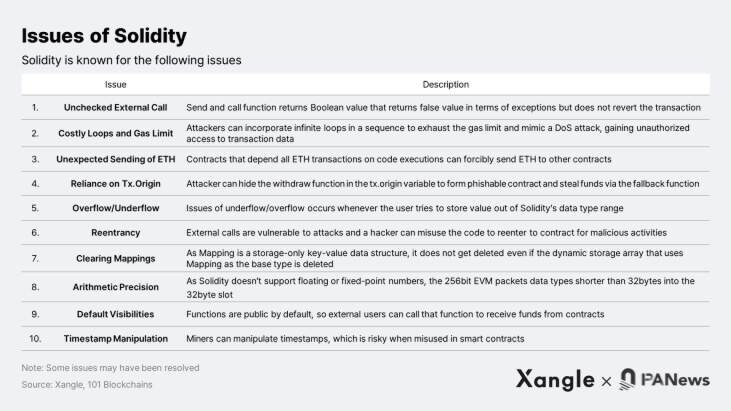
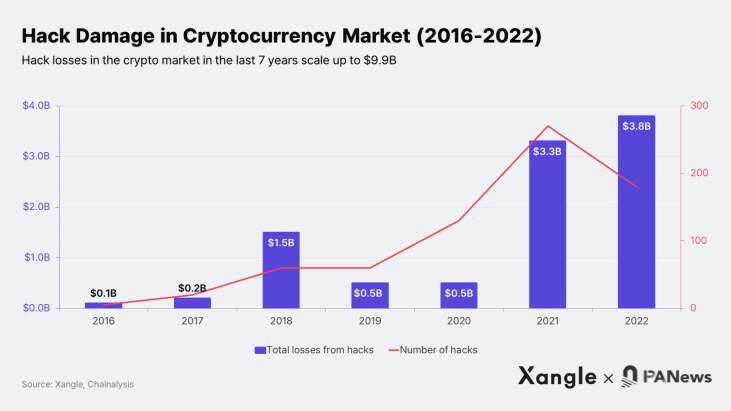
It is difficult to modify smart contracts after deployment. This is why projects need to go through multiple rounds of technical audits before releasing dapps. However, the difficulty lies in the dynamic dispatch of Solidity contracts, as it is not possible to predict other unexpected variables that may occur before execution. As the demand for more secure programming languages continues to grow, developers are increasingly attracted to the security and advantages of Move and MoveVM.
Move is an open-source programming language based on Rust developed by Meta. It is known for its stability superior to Solidity and can accelerate the process from development, testing to deployment. This is thanks to several key features of Move: 1) support for first-class assets to prevent arbitrary issuance and deletion of assets; 2) support for static dispatch to enhance code verification; 3) reduce verification time through proofs; 4) ensure that the code works as expected by developers; 5) provide memory safety similar to Rust, making memory management easier. These features together make Move a reliable and fast development environment for developers.

2-3. Ecosystem: Flourishing with the full support of the Aptos Foundation
Since the mainnet went live in October 2022, the growth of Aptos has been steadily rising. According to Aptoscan data, a total of 4 million wallets have been created, with an estimated 50,000 to 100,000 new wallets created daily. The daily trading volume has also remained around 500,000 transactions. As of June 13, 2023, the Aptos ecosystem has had 275 projects launched, including 113 NFT projects, 67 infrastructure and middleware projects, 46 DeFi projects, and 18 gaming projects. In terms of TVL (Total Value Locked) calculation, LianGuaincakeswap, Thala (Thalaswap, ThalaCDP), and Liquidswap dominate the DeFi market, accounting for 95% of Aptos’ $44 million TVL.
In the gaming field, NPIXEL’s Web3 gaming platform METAPIXEL has gained significant attention in the Aptos ecosystem. Especially, “Gran Saga: Unlimited,” an MMORPG chain game that combines NPIXEL’s popular game “Gran Saga” IP, is one of the most anticipated games.

However, Aptos is still significantly smaller than other well-known blockchains such as Ethereum, Polygon, Arbitrum, and BNB Chain. The ecosystem currently lacks killer dApps or highly anticipated NFT projects. The Aptos Foundation is well aware of this and actively carries out various funding programs, including hackathons. Earlier this year, Aptos concluded its Phase 1 funding program, providing $3.5 million to over 50 projects, including Apscan, Bruhbears, and Intu.xyz. Subsequently, the Phase 2 funding program was launched, which consists of two categories: Artist Grants and the Aptos and Google Cloud Accelerator Program.
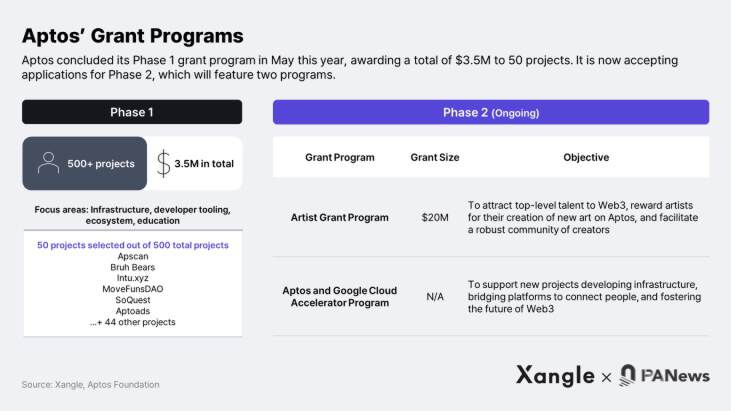
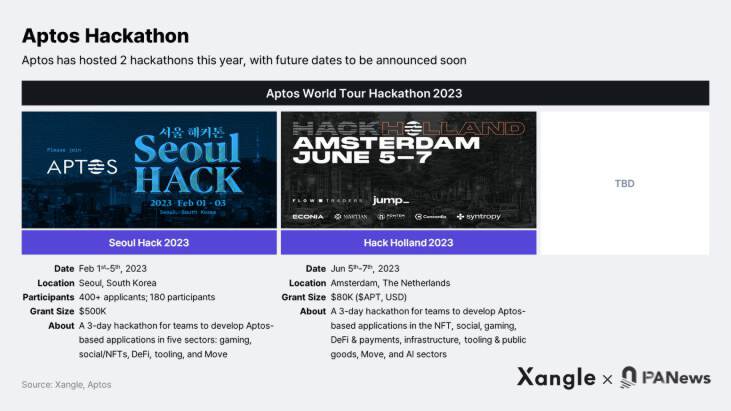
2-4.Token Economics: Longer Redemption Period and Stable Inflation Rate
Here are some key data about the native token $APT of Aptos:
- Maximum supply: Infinite
- Total supply: 1,038,484,105 $APT (100%)
- Current circulation: 200,288,451 $APT (19.3%)
- Inflation rate: 5.6% (decreasing annually, lowest around 2.6%)
- Staking rate: 860,195,091 $APT (82.8%)
The staking reward of $APT starts at 7% per year and decreases by 1.5% annually until it reaches 3.25%. The estimated initial inflation rate is around 5.6%, which is expected to decrease to 2.6% over time. As more than 50% of the initial supply will be in circulation within about two years, $APT will have some potential risks. However, due to the long release period of 10 years, the initial inflation rate of $APT is not high compared to other L1 tokens. For example, according to data from Xangle Analytics, the inflation rate of Ethereum was above 10% in 2016 to 2017, but it has gradually decreased to 4% after the merge. In addition, the inflation rate of $APT is lower than most other L1 tokens, which usually experience high inflation rates of over 10% in the early stages of mainnet launch (BNB: 16%, AVAX: 800%, MATIC: 80%, NEAR: 200%).
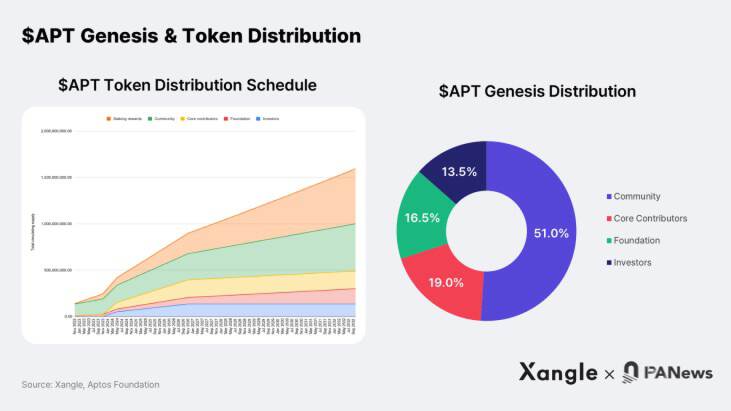
Currently, the staking rate of $APT is approximately 82.8%, which exceeds the percentage of circulation. This is attributed to Aptos’ design that allows for the staking of locked tokens. Although some members of the community have expressed their concerns, this design may have a positive impact on the network if the inflation rate is not too high, as: 1) the security of a PoS chain is directly proportional to the value of staked tokens, and 2) protocols wishing to join the Aptos ecosystem can utilize locked $APT to enjoy staking rewards.
3. Future Vision of Aptos
Aptos’ core strategy involves two key aspects: 1) ensuring the network is future-oriented through scalability, and 2) attracting Web2 enterprises with its extensive capital and network.
3-1. Growth Strategy (1): Building a Future-Oriented Network through Scalability
Aptos intends to leverage its scalability to build a future-oriented network capable of accommodating 1 billion users. Unlike other blockchains such as Ethereum, Solana, and Cosmos, which typically deploy major protocol updates every six months to a year, Aptos aims to become the most powerful blockchain in the long run through its fast and efficient upgrade system. In fact, within eight months since the launch of its mainnet on October 12, 2022, Aptos has already passed 24 AIPs, including core layer upgrades such as AIP4, AIP17, and AIP26 (Quorum Store).
AIP17 will be implemented in March 2023, aiming to reduce transaction execution costs by separating the logic of Gas fees related to storage and execution of transactions. The idea is to allocate absolute values of Gas fees for transaction types that involve storage, while retaining the existing fee market mechanism for execution Gas fees. In this way, Aptos is able to reduce the Gas fees for transaction types such as UnlockStake, RotateConsensusKey, Transfer, and WithdrawStake by approximately 99%. Quorum Store, also known as AIP26, is a NarwhalBFT consensus designed specifically for the Aptos architecture. Its purpose is to address existing consensus bottlenecks, such as wastage of node bandwidth or duplicate propagation of the same transaction data during the block consensus process. Aptos has tested Quorum Store on Previewnet and reported a throughput increase of more than 3 times. Recently, Aptos has been researching Shoal, a framework that will introduce pipeline and leader node reputation mechanisms. The introduction of Shoal is expected to reduce the latency of Narwhal-based consensus algorithms such as Bullshark, Tusk, and DAG-Rider by approximately 40-80%.
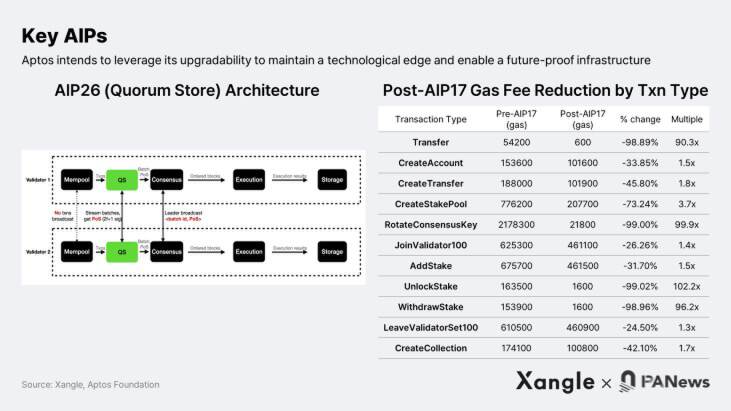
Aptos is capable of supporting fast and immediate upgrades thanks to its modular architecture, which allows protocol upgrades without the need for hard forks, and a chain governance system that facilitates real-time release of upgrades. These features ensure that Aptos does not experience any downtime during AIP updates.
3-2. Growth Strategy (2): Expansion of an ecosystem centered around Web2 companies
Unlike most L1s that prioritize ecosystem development with Web3 projects, Aptos’ ecosystem expansion will revolve around large enterprises. The goal of this approach is to launch reliable products and services and introduce the IP and user base of Web2 companies.
Aptos strategically leverages its capital and network to attract Web2 companies. Last year, Aptos completed seed and Series A financing totaling $3.5 million, with investors including a16z, LianGuai Ventures, Apollo Global Investment, Tiger Global Management, Griffin Gaming Partners, Multicoin Capital, and Jump. Considering that Aptos has committed to allocating 51% of the total supply of $APT to ecosystem development, it appears to have provided sufficient funding for partners.
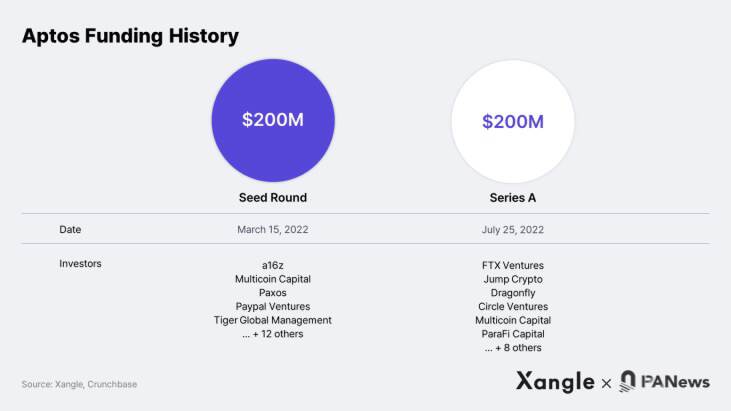
Aptos co-founder Mo Shaikh has previously worked at BlackRock, BCG, Consensys, and Meta, while co-founder and CTO Avery Ching has worked as a software engineer at Yahoo, Meta, Novi, and the Alianca Software Foundation. Additionally, the experienced team and the network of well-known investors are advantageous for maintaining the company’s engagement.
Aptos’ primary target markets are four key markets: 1) Gaming, 2) Finance, 3) Media and Entertainment, and 4) Social Networks. Aptos is currently collaborating with Mastercard and Google Cloud to lay the foundation for growth. In the Korean market, Aptos seems well-prepared to enter the gaming and media/entertainment markets, as it has received investments from Hashed, Irongrey, Hybe, YG, and has important partnerships with NPIXEL.
3-3. Long-term plan to provide dedicated blockchain space for companies
Among the major Korean companies that recently announced their entry into Web3, such as Nexon, SK Planet, Com2uS, Neowiz, and NPIXEL, only NPIXEL has chosen a single chain. For those who are hesitant about building their own L1, the main advantage of these L1s is the availability of development infrastructure, such as SDKs, which can simplify the process of building the mainnet.
The main motivation for building their own mainnet is to have 1) network control and 2) their own blockchain space. In the former case, Aptos may be a viable choice, depending on the company’s scale and business model, as it eliminates the burden of operating the mainnet, including time, cost, and development resources.
In the latter case, for companies with a high demand for dedicated blockchain space, a public blockchain may not be a direct choice. This is because in the operational structure of a public blockchain, all participants have to compete for the same resources. It is worth noting that Aptos’ high scalability allows all services to share the same blockchain space, but potential risks of building their own blockchain, such as security, reliability, liquidity, and fragmentation of data availability, should not be overlooked.
Solana introduced stake-weighted PoS in the second half of last year, providing an alternative solution that provides and guarantees network bandwidth based on the proportion of SOL staked. Aptos takes a different approach by incorporating sharding into its solution. A demo version will be released in the next 6 months to a year.
4. The gaming industry will lead ecosystem growth
4-1. Ecosystem growth driven by METAPIXEL
As part of the strategic partnership established with NPIXEL in November 2022, Aptos will exclusively feature games developed by NPIXEL’s blockchain division. NPIXEL, founded in 2017, is a Korean game developer that completed a Series B investment of 100 billion KRW in 2022, becoming a unicorn in the gaming industry in the shortest amount of time. One of their flagship games is the globally popular mobile game “Gran Saga,” which has been downloaded 4.2 million times and has generated a cumulative revenue of 180 billion KRW, with a monthly ARPPU (Average Revenue Per Paying User) of $200. METAPIXEL is a Web3 game ecosystem based on the Aptos public chain developed by NPIXEL. The first game, “Gran Saga: Unlimited,” will be launched in January 2024. As an extension of NPIXEL’s flagship IP, “Gran Saga: Unlimited” achieved a retention rate of 70% to 80% among 500 participants in its first closed beta test.
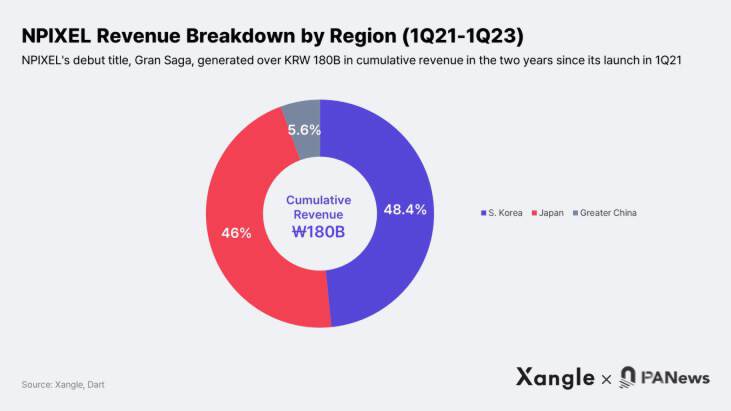
In addition to “Gran Saga: Unlimited,” METAPIXEL is also developing and operating the Pixelcraft and Catcha projects. Pixelcraft is a 2.5D hyper-casual pixel art RPG game expected to launch in the first half of next year. “Knight Survivor” is a mini-game within Pixelcraft, with a daily revenue of 1.5 million KRW and an average daily active user (DAU) of 7,000 to 8,000. The success of this game helped METAPIXEL reach 80,000 subscribers within the first half of 2023 and may serve as a triggering factor for further development of the Aptos ecosystem.
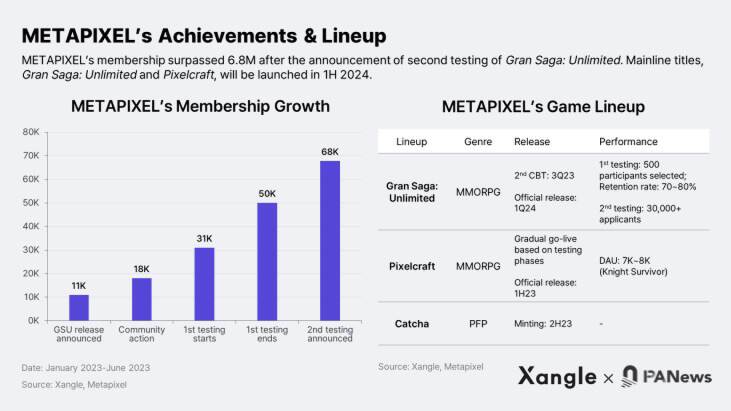
4-2. The game industry is expected to promote the vigorous development of the ecosystem
In the foreseeable future, the game industry may become a major catalyst for the growth of the Aptos ecosystem index. Aptos is one of the few public chains with the ability to support 3A game technology. Aptos is also partnering with METAPIXEL to build the necessary infrastructure and tools to simplify the Web3 game development and publishing process.
When choosing a blockchain platform to build a project, speed and reliability may be the primary considerations for game companies. Depending on the degree to which the game experience is realized on the chain, a fully on-chain MMORPG that applies blockchain technology to all goods and items will involve processing thousands to tens of thousands of transactions per second, making Aptos a natural choice for game companies.
In addition, Aptos and METAPIXEL are collaborating on the development of various game-related infrastructure and tools to make it easier for game developers and players to join the blockchain ecosystem. Currently, one of the biggest challenges in developing blockchain games is the poor development environment. Aptos and NPIXEL are working together to develop standardized implementation values to facilitate the smooth transition of game companies from Web2 to Web3, for example:
- Token objects (AIP11): METAPIXEL improves the following areas by transitioning from the initial token v1 model of Aptos to the object model (token v2):
- NFT at the same level as user accounts: In order to handle resources more intuitively and directly, NFTs are identified by a 32-byte address, just like user accounts.
- Enhanced ownership identification: The owner field of an object can easily identify the owner of an NFT. It simplifies the ownership verification and transfer process and promotes composability.
- Efficient storage utilization: Grouping objects and related resources, as well as the previously defined ObjectCore, can effectively utilize storage space, thereby reducing storage costs.
- Dynamic and flexible NFTs: Through the Token Object model, game assets can be managed dynamically and flexibly. A single Token object can be used to mint game NFTs, grant Soulbound status, and upgrade attributes.
- Proxy gas fee payment: In order to achieve a user experience comparable to Web2 games, Aptos is building an open-source proxy gas fee payment system. This system includes two key features: 1) Multi-proxy transactions that can activate multiple operations in a single transaction; 2) Remote signing process to remotely sign transactions for game players.
- Verifiable random function (VRF): One of the greatest benefits of introducing blockchain technology into games is transparency. METAPIXEL and Aptos Labs have developed VRF to improve the transparency and reliability of the gacha system.
- Stackable (TBD): Developing a new token standard to achieve semi-fungible NFTs similar to ERC1155.
- SDK: Aptos plans to develop an SDK to simplify the process of building games on its network.
4-3. Emerging, long-term observation required
The Aptos mainnet has only been launched for about 9 months, and almost all indicators lag behind some established L1s, including infrastructure, TVL, developer community, and user count. Ethereum, as the leading blockchain, continues to dominate not only because of its superior infrastructure but also due to the continuous influx of capital and talent (including developers and researchers): Ethereum’s TVL is 615 times higher than Aptos, full-time developers are 26 times more, and Github repositories are 49 times more than Aptos. Therefore, the emerging status of Aptos requires investors and stakeholders to remain patient and observe in the long term, although comprehensive growth may start to appear next year with the launch of the aforementioned gaming infrastructure and development tools in the second half of this year.

Like what you're reading? Subscribe to our top stories.
We will continue to update Gambling Chain; if you have any questions or suggestions, please contact us!